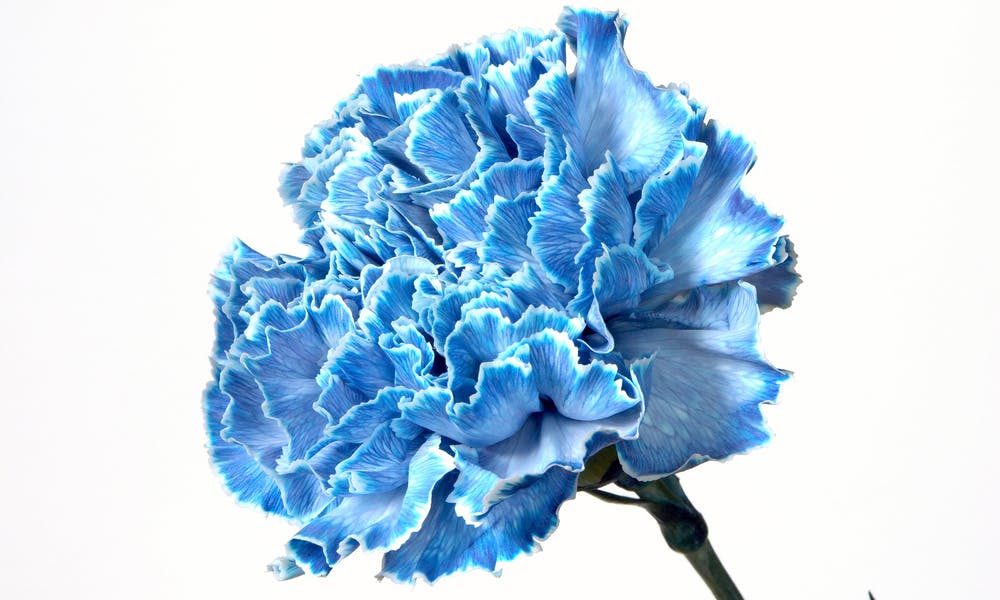Blue carnations are a rare variety of carnation that have been genetically modified to produce a blue pigment. Unlike natural carnations, blue carnations do not exist in the wild and are instead the result of a laboratory process that involves injecting the white petals with a blue dye. While blue carnations are not natural, they are popular among gardeners and florists for their unique color and beauty. However, some people have concerns about the safety and ethical implications of genetically modifying plants.
Blue carnations are flowers that don’t grow naturally anywhere in the world. This variety of carnations doesn’t have a long background or history and has only recently become commercialized. The bloom is exceptional and makes a stunning statement wherever it’s displayed.
In this article, you are going to learn:
- The background of the blue carnation
- Origins of how the flower was created
- How to maintain and care for a blue carnation
- Other blue flowers to consider that grow naturally around the world
A Brief Background
Carnations are usually seen in traditional colors that include red, pink, and white. Over time, people came to realize that flowers can easily change color with a simple dip in food coloring and water. In the 1970s, florists and households started to dip white carnations in hued water to create fun and funky colors to sell and enjoy.
About 30 years later, Australian researchers decided to find out more about the carnation and its adaptability. They knew the flower had the capabilities to change its look with a basic water dipping experiment, but what if they combined genetic engineering with the mix? They knew they were possibly looking at a breakthrough when it came to the carnation and the flower industry. Through trial and error, the scientists genetically engineered their first carnation. The flower was violet-blue and named “Moondust.
Origins of the Blue Carnation
How did the 12 scientists come up with this amazing feat? It took a lot of time and patience. The color blue doesn’t come naturally to most flowers found in nature. Researchers have also found out that traditional breeding methods have limitations when it comes to expanding color ranges.
The Australians worked for a decade to find the gene that makes a petunia blue. Once they isolated that material, the goal was to transfer the gene to the carnation. Over time, they have managed to make five varieties of carnations that have different inflections of color.
The original intent of the researchers was not to make the Moondust carnation. They were working on finding a way to engineer a blue rose. However, the rose is much harder to manipulate due to complexities in its genetic makeup. The Australians decided to use the much easier to work with carnations to try and learn from and transfer genes between the two flowers. While the scientists haven’t stopped working to create a blue-tinged rose, they are proud of the accomplishments they made with the carnation.
Blue Carnation Care and Maintenance
If you are lucky enough to get your hands on the Moondust carnation, you need to follow these tips to ensure the blooms are going to last a long time. Blue carnations are currently under license and are not available for planting in gardens. Access to the flowers is limited and hard to find. When you do find a florist that carries the rare bloom, treat the flowers gently.
Place the stunning beauties in a vase that is partially filled with lukewarm water. Add plant food to the water to increase their life span. If the ends aren’t already trimmed, do so now. You should always cut the stems diagonally. If you prefer to place the flower near a window, make sure the sun exposure is not too intense. The heat can cause the petals to curl in and brown.
Other Blue Flowers
Even though blue doesn’t come naturally when it comes to the carnation, there are other flowers that you can find with exotic coloring.
Bellflower—The bellflower is a blue and violet flower that lives up to its name. The bell-shaped bloom grows naturally in full sunlight and makes great flowers to add to your bouquets.
Periwinkle—The periwinkle plant looks almost fern-like with blue-hued flowers dotting the foliage. The sweet-looking blooms are a favorite when it comes to ground-covering plants. For those of you without a green thumb, this plant is for you. The periwinkle needs minimal care and maintenance and is drought resistant.
Hydrangea—Hydrangeas are known for their big and grand blue blooms. The large heads are made up of small flowers that grow together to form a ball-like structure. The flower smells fragrant and is popular in gardens and homes. A fun fact about this flower: If you increase the acidity of the dirt it’s growing in, you are going to get a lighter shade of blue!
Harvestbells—Harvestbells are perennials that grow low to the ground. These plants are known to attract wildlife that eats the flowers and foliage for nourishment. The violet-blue petals turn back to replicate a bell shape. The harvest bell can grow in all types of environments and do well in dry regions. Certain varieties of plants grow best in sandy soil.
Lungwort—The lungwort is an early bloomer. The deep violet flowers mature in the spring and love shade and cooler regions. If you are searching for a vibrant blue to include in your garden, consider the lungwort.
Blue flowers are highly sought after and enjoyed. Blue carnations are flowers that are just starting to expand into that color realm and have been met with anticipation and excitement. Hopefully, we are going to see the Moondust flower in more homes and gardens in the next few years.
